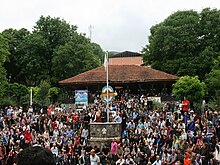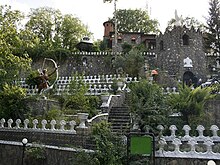Kandolus
This article has multiple issues. Please help improve it or discuss these issues on the talk page. (Learn how and when to remove these messages)
|
Kandolus
| |
|---|---|
Village | |
| Coordinates: 36°19′27″N 51°34′02″E / 36.32417°N 51.56722°E[1] | |
| Country | |
| Province | Mazandaran |
| County | Nowshahr |
| District | Kojur |
| Rural District | Zanus Rastaq |
| Population (2016)[2] | |
• Total | 1,092 |
| Time zone | UTC+3:30 (IRST) |

Kandolus (Template:Lang-fa, also Romanized as Kandelous, Kandolūs, Kandelūs, Kandloos, and Kandlūs; also known as Gendulas)[3] is a village in Zanus Rastaq Rural District of Kojur District, Nowshahr County, Mazandaran Province, Iran.
As of the 2006 National Census, its population was 115 in 45 households. [4] The following census in 2011 counted 915 people in 273 households. [5] The latest census in 2016 showed a population of 1,092 people in 378 households; it was the largest village in its rural district. [2]
Kandolus Museum
This section needs additional citations for verification. (May 2023) |
Kandolus Museum is located in Kandolus. It was established between 1360 and 1368 through the efforts of Dr. Ali Asqar Jahangiri.
The exhibits in this museum come from before Christ and Islam. The exhibits are classified into different sections. They include weaves, clothes, rural ornamentations, statues, traditional paintings, metal and wooden cutleries and crockeries and china from antiquity the Qajar dynasty.
The museum was host to more than 60,000 tourists from Iran and countries around the world in 2011.[citation needed]

Kandelous is a village in the functions of Kajur district of Nowshahr city in Mazandaran province of Iran. Kendlos village, with four thousand years of history, in the heart of the Alborz mountain. Kendlos village is located along the Zanos valley, and the green area of Kajur, one of the first and oldest human settlements in Mazandaran province.

The discovery of historical objects such as clay cups and tools of life and agriculture, weapons, locks and ornamental objects, represents an ancient civilization that is at least four thousand years old. The documents and objects were collected by the efforts of Dr. Ali Asghar Jahangiri in the Anthropological Museum of Kandelous (located in the same village) and are open to all. One of the attractions of this area is the Anthropology Museum and the Botanical Museum of Kandelous, which presents information about the ancient history and the civilization of the area.[citation needed]

Kandolus Agricultural Complex
This section needs additional citations for verification. (May 2023) |
Dr. Jahangiri is also building the Kandelos Agricultural Complex with the aim of being able to do the same for the deprived and remote areas of Kandelos. Registration for the Cultural and Charitable Institute was also one of the projects being undertaken at the same time as the Hexane and Kandelus Agricultural Complex.
See also
References
- ^ OpenStreetMap contributors (27 May 2023). "Kandolus, Nowshahr County" (Map). OpenStreetMap. Retrieved 27 May 2023.
- ^ a b "Census of the Islamic Republic of Iran, 1395 (2016)". AMAR (in Persian). The Statistical Center of Iran. p. 02. Archived from the original (Excel) on 7 October 2021. Retrieved 19 December 2022.
- ^ Kandolus can be found at GEOnet Names Server, at this link, by opening the Advanced Search box, entering "-3069514" in the "Unique Feature Id" form, and clicking on "Search Database".
- ^ "Census of the Islamic Republic of Iran, 1385 (2006)". AMAR (in Persian). The Statistical Center of Iran. p. 02. Archived from the original (Excel) on 20 September 2011. Retrieved 25 September 2022.
- ^ "Census of the Islamic Republic of Iran, 1390 (2011)". Syracuse University (in Persian). The Statistical Center of Iran. p. 02. Archived from the original (Excel) on 19 January 2023. Retrieved 19 December 2022.
External links

